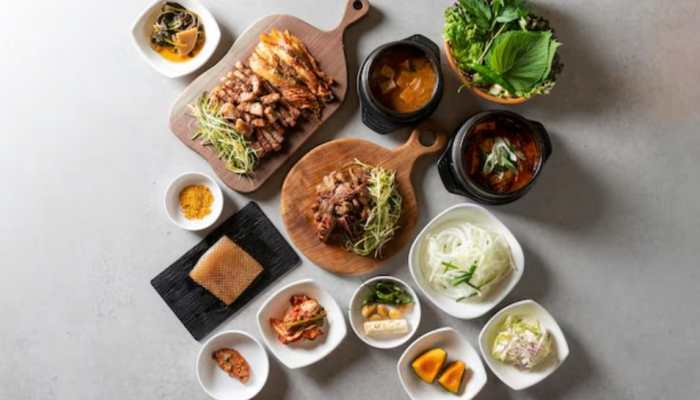Localising Korean Flavours: The Rise Of Indo-Korean Fusion In Packaged Foods
For both food enthusiasts and industry players, this fusion represents an exciting blend of two rich culinary traditions, promising to delight taste buds and expand horizons in equal measure.
Trending Photos
) Image credit: Freepik
Image credit: Freepik In recent years, Korean cuisine has surged in popularity globally, and India is no exception. The influence of K-dramas, K-pop, and cultural exchange has sparked a love for Korean flavors among Indian consumers. This fascination has paved the way for a unique culinary trend: Indo-Korean fusion, particularly in the packaged food sector. By blending Korea’s bold, umami-rich flavors with India’s spice-laden palate, this fusion offers a delightful gastronomic experience that caters to local tastes.
The Appeal of Korean Cuisine in India
Korean cuisine is known for its vibrant flavors, which balance sweet, spicy, savory, and tangy elements. Signature dishes like kimchi, ramyeon (Korean instant noodles), bulgogi (marinated beef), and tteokbokki (spicy rice cakes) have captured the imagination of Indian food enthusiasts. The emphasis on fermented ingredients, hearty broths, and fiery sauces resonates with India’s love for strong, layered flavors.
The rise of Korean food is also fueled by Indian consumers’ openness to international cuisines. The accessibility of Korean ingredients through online retailers and the influence of social media have made it easier to experiment with and adapt these flavors at home.
Fusion in Packaged Foods
Packaged foods have been at the forefront of Indo-Korean fusion. Companies are capitalizing on the popularity of Korean flavors by tailoring them to suit Indian preferences. Here's how this fusion is shaping up:
1. Spicy Korean-Style Snacks
Indian snacks are known for their bold flavors, and Korean-inspired variations fit seamlessly into this category. For example:
Kimchi-flavored potato chips with a hint of tanginess and spice.
Gochujang (Korean chili paste)-coated peanuts for a fiery, crunchy snack.
Seaweed masala crisps, combining the umami of seaweed with Indian spice blends.
2. Instant Noodles with a Twist
India’s love for instant noodles is legendary, and Korean-inspired noodles have found a strong market:
Companies are launching masala ramyeon, where the traditional Korean broth is paired with Indian spice mixes.
Butter chicken-flavored Korean noodles merge two beloved comfort foods from each culture.
3. Korean Sauces and Dips with an Indian Spin
Korean sauces are being localized for Indian kitchens:
Gochujang chutney, with added sweetness or tang to appeal to Indian palates.
Kimchi achar, combining the fermentation techniques of kimchi with Indian pickling spices.
Tandoori-flavored Korean BBQ sauce, perfect for marinades and dips.
4. Frozen Meals and Ready-to-Cook Kits
Frozen meals featuring Indo-Korean fusion are gaining popularity:
Paneer bulgogi wraps, where Korean barbecue meets Indian cottage cheese.
Tteokbokki with Indian curry flavors, offering the chewy texture of rice cakes with familiar spices.
Challenges and Opportunities
Challenges
Balancing Authenticity and Adaptation: While it’s important to stay true to Korean culinary roots, products must also cater to Indian taste preferences.
Ingredient Accessibility: Ingredients like gochugaru (Korean chili flakes) or doenjang (soybean paste) may still be unfamiliar to many Indian consumers.
Competition: The packaged food market in India is highly competitive, with numerous local and international players.
Opportunities
Cultural Exchange: The fusion trend provides an excellent opportunity to celebrate cultural diversity and introduce Indian consumers to global flavors.
Growing Market for Experimentation: Young, urban consumers are adventurous and eager to try new foods, making them an ideal target audience for such products.
Health-Conscious Offerings: By emphasizing the health benefits of fermented foods like kimchi, brands can tap into the growing wellness trend.
The Road Ahead
The Indo-Korean fusion trend in packaged foods is a testament to how global culinary influences can be adapted to local markets. As Indian consumers continue to embrace Korean culture, the potential for innovation in this space is immense. From street-style snacks to gourmet sauces, the possibilities are endless.
(This article is intended for your general information only. Zee News does not vouch for its accuracy or reliability.)
Stay informed on all the latest news, real-time breaking news updates, and follow all the important headlines in india news and world News on Zee News.
Live Tv







)
)
)
)
)
)
)
)
)
)
